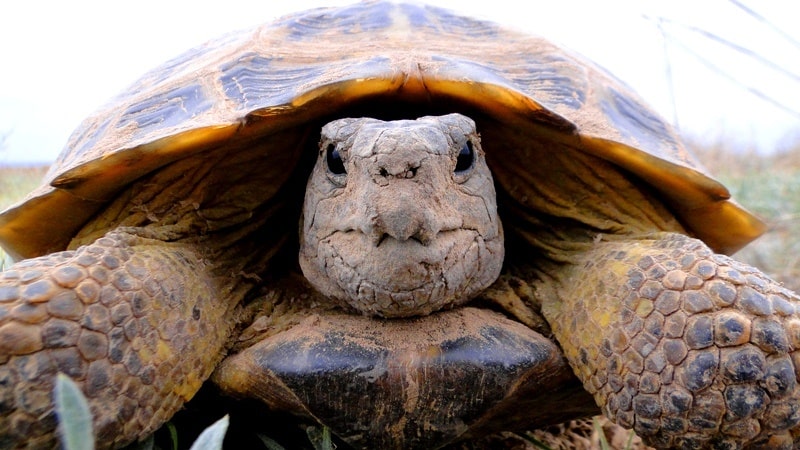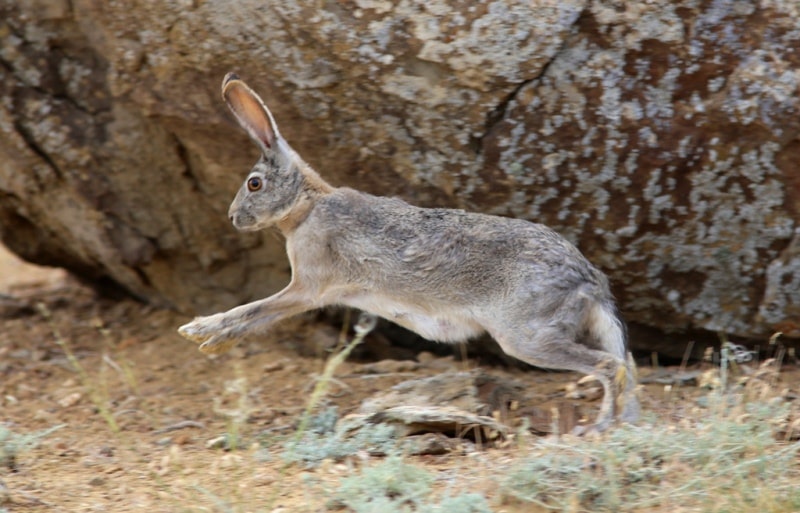You are here
Fauna of Mangystau.

Photo tours for wild animals of Mangystau.
"Cruelty towards animals cannot exist either where people are truly educated, or where true learning reigns. This cruelty is one of the most characteristic sins of a base and ignoble people."
Alexander Humboldt (1769 - 1859, founder of scientific geography.
Protected areas of Kazakhstan.
The fauna of mammals in the Mangystau-Ustyurt zone is typically desert. It is inhabited by the piebald shrew - a large shrew with a characteristic longitudinal white spot on its back and is listed in the Red Book of the Republic of Kazakhstan.
In the sands of Kzrynzharyk and along the chink of the Ustyurt plateau, there is a long-legged hedgehog, which is also listed in the Red Book of the Republic of Kazakhstan. Rodents are the most numerous group of mammals in Mangistau and Ustyurt, where large and small jerboas, tarbagan or earthen hare, hopper jerboa, Severtsov's jerboa live, - fat-tailed jerboa and emberglide.
There are also four species of gerbils, two species of ground squirrels, a gray hamster, and a house mouse. The fauna of predatory animals is made up of caracal, spotted cat, sand cat and manul. The spotted cat is also called the steppe cat. In the early 60s, up to 210 skins of this animal were harvested in Mangistau and Ustyurt.
The wolf also lives on Mangistau - a strong, gluttonous predator. Usually he grabs his victim by the throat, gnaws at it or rips open the peritoneum, tears meat and tendons with pieces. A pair of wolves can easily eat a ram in one go.
One wolf eats about a ton of meat annually. Having burst into the herd or penetrated into the koshara, several gray robbers mercilessly slaughter up to -70 - 80 sheep. Only in one natural boundary Karatuley in the spring, when there is a massive, almost simultaneous, thousands of saiga lambing, wolves destroy up to 30 - 40% of saigas.
These predators inflict the same harm on other wild ungulates - gazelles, mouflons, boars. The saiga is a medium-sized animal, the size of a medium-sized sheep. This animal does not resemble any of the living ungulates. The saiga has an elongated body and thin, relatively short limbs.
The color of saigas changes with the seasons of the year and mainly corresponds to the color background of the main habitats. The saiga is a fast animal, it is capable of developing speeds up to 75 - 80 km/h. Saigas swim well.
The famous Russian traveler and zoologist G. S. Karelin wrote that he saw herds of saigas in 2000 heads. In 1986, a scientific writer flashed a message from L. N. Korinthsky, who described a meeting with a honey badger in October 1883 on the territory of the Mangistau region, in the town of Turyk.
In 1987, a group of employees of the Ustyurt Reserve to the north of the Uners River found a burrow and near it a trace of an unknown animal. When excavating the burrow, a peacefully sleeping honey badger was discovered.
The awakened animal turned out to be an adult male, rather aggressive - it rushed at people, growled muffledly. Fighting off people, the honey badger emitted a sharp unpleasant smell. The beast looked like a badger, but more massive; with sparse wool.
The honey badger is omnivorous - it can eat both plant and animal food - mice and gophers, turtles and lizards, various insects. Why is this beast called a honey badger? This question was answered by K. Plakhov - Deputy Director of the Ustyurt State Reserve for scientific work.
In India, where this animal lives, as K. Plakhov explained, there is a legend that the honey-guide bird finds a family of bees and shows the way to the animal. The animal gets to the honeycomb, eats honey, and the bird feasts on the honeycomb.
The first naturalists who described this rare animal also heard the legend and called the beast a honey badger. The honey badger found on Mangystau is listed in the international Red Book of Kazakhstan. The mouflon lives on Ustyurt - an agile animal, dexterous and fast. He easily descends and climbs the steep slopes of the chinks, jumping from rather high ledges.
If necessary, the mouflon makes high (up to 1.5 m) jumps, often jumps from a height of up to 10 meters. This animal is also common in the outlier uplands and depressions of Mangistau (Karagiye, Kuandy, Zhazgurly), on the coast of the Karabogazgol Bay.
Until 1960, mouflons were found in small numbers at Cape Minsualmas and on the coast of the Kazakh Gulf. G.S.Karelin discovered mouflons at Ustyurt in the Yaman-Airakty mountains, in the Misty mountains, near the southern coast of Dead Kultuk.
NL Severtsov met them in the Kaidak Bay and on the Karatau and Aktau ridges. This was also confirmed by N.P. Lomakin (1873), A.A. Ostroumov (1890), who obtained a copy in Karatau. Mouflons were discovered in May-June 1964 on Mangistau in the Northern Aktau and Karatau mountains, in the western cliffs of Ustyurt in the area of the Karynzharyk depression and north of it, in the area of the Dead Kultuk and Kaidak sors.
Female mouflons are caring mothers. Such a case is described: “April 3, 1965 - a disturbed female with a lamb began to leave along a narrow steep slope between the cliffs. Soon the lamb hid. After 10 minutes, he suddenly left the shelter and, not finding a free exit, began to rush around the site, bleating alarmingly.
Despite the proximity of the man (50 meters away), the female ran up to the calf and began to take him away along more accessible parts of the slope. Further, the passage continued along the stepped ledges between the cliffs.
The female, moving in front of the lamb, easily passed this obstacle and stopped, watching the lamb. The latter tried to follow her, but was unable to jump onto the ledge; without trying to overcome the obstacle a second time, he began to scream in alarm again.
The female returned to him and more slowly repeated the maneuver. The second attempt at lamb was also unsuccessful. The female, busy with the lamb, did not pay attention to the person who was near. Seeing that the lamb would not pass here, the female went down and led him in the opposite direction.
Camels, Bactrians and dromedaries - two-humped and one-humped almost everywhere live on Mangystau. Camels are represented by three breeds - Kazakh, Kalmyk and Mongolian. Over the course of centuries of selection, the inhabitants of the deserts have singled out the breeds of meat-wool, meat-and-milk and pack-walking, draft and fast-paced camels.
On pastures, camels are kept in small family groups, often next to horse herds and flocks of sheep. Camel milk is used to make a popular Kazakh dairy national drink - shubat, which has a number of advantages over other dairy products.
Besides Bactrians and dromedaries, there are a large number of their hybrids. The most famous of the hybrids is the Nar, a cross between a Bactrian mother and a dromedary father. Nar is the hero of many Kazakh fairy tales.
Iner is a cross between a Bactrian father and a dramoder mother. These are hybrids of the first generation from crossing camels. In the second, third and fourth generations, they receive hybrids of Balkospak (Narmaya-mother - Bactrian-father), Zhun (inermaya or Narmaya-mother - dramoder-father), Kurt (Jun-mother - dromedary-father), Kurt-nar (Kurt- mother - Bactrian father), Koznar (myrzakospak mother - dromedary father). Hybridization "in itself" leads to the degradation of the offspring.
The Kazakhs call the animals obtained from such crossbreeding "zharbai", which means "scarecrow" or "scarecrow". Of the arachnids in the Mangistau-Ustyurt zone, tarantula, scorpions, karakurt, phalanx live. The tarantula lives in burrows, on the banks of temporary streams, lakes, swamps and salt marshes.
Tarantul bites are painful but not fatal. Scorpions are nocturnal, grabbing prey with claws and stinging. A scorpion bite for humans (except for children) is not fatal, but very painful. The most dangerous of the arachnids is poisonous karakurt. It is black in color with red dots on the abdomen.
The female, karakurt, makes a lair in the soil, holes of rodents, stretching the threads at the entrance, into which the victims fall - grasshoppers, crickets, bears, locusts and other insects. Karakurt is very prolific. In July, the female lays from 100 to 700 eggs, braiding them with a cocoon.
Spiders hatched from eggs hibernate in a cocoon, in April of the next year they leave the cocoon and settle, highlighting a cocoon. Karakurt does not attack animals and humans if they are not disturbed. The bite of a karakurt, especially a female, is fatal to humans and animals. In the absence of medical assistance, death occurs in 1 - 2 days.
The poison of karakurt is 15 times stronger than the venom of a rattlesnake. A rapidly disappearing red spot appears at the site of the bite, after 10 - 15 minutes a sharp pain occurs in the abdomen and chest, legs go numb.
In the absence of serum, cauterization of the bite with the flame of a match head is recommended, but no later than two minutes after the bite.











Authority:
M. A. Mirzoev. "Mangystau: Voices of Centuries". Almaty, Kazakhstan, 1994. 240 pp.
Photos by
Alexander Petrov.







